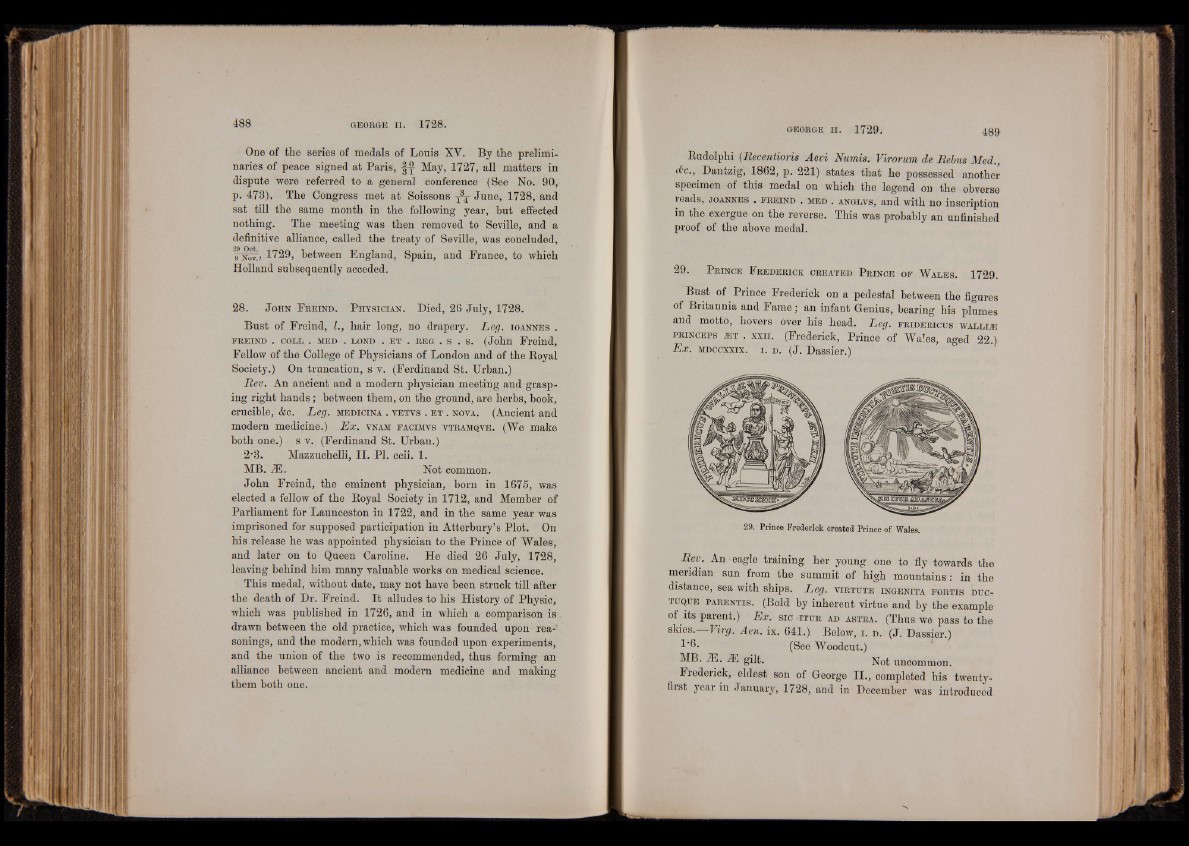
One of the series of medals of Louis XV. By the preliminaries
of peace signed at Paris, May, 1727, all matters in
dispute were referred to a general conference (See No. 90,
p. 473). The Congress met at Soissons ^ June, 1728, and
sat till the same month in the following year, but effected
nothing. The meeting was then removed to Seville, and a
definitive alliance, called the treaty of Seville, was concluded,
~g n°t!) 1729, between England, Spain, and France, to which
Holland subsequently acceded.
2 8 . J o h n F r e in d . P h y s ic ia n . Died, 2 6 J u l y , 1 7 2 8 .
Bust of Freind, /., hair long, no drapery. Leg. io a n n e s .
f r e in d . co l l . m e d . lo n d . e t . r e g . s . s. (John Freind,
Fellow of the College of Physicians of London and of the Royal
Society.) On truncation, s v. (Ferdinand St. Urban.)
Rev. An ancient and a modern physician meeting and grasping
right hands; between them, on the ground, are herbs, book,
crucible, &c. Leg. m e d ic in a . v e t v s . e t . nova. (Ancient and
modern medicine.) Ex. vnam fa c im v s v tr am q v e . (We make
both one.) s v. (Ferdinand St. Urban.)
2‘3. Mazzuchelli, II. PI. ccii. 1.
MB. IE. Not common.
John Freind, the eminent physician, born in 1675, was
elected a fellow of the Royal Society in 1712, and Member of
Parliament for Launceston in 1722, and in the same year was
imprisoned for supposed participation in Att.erbury’s Plot. On
his release he was appointed physician to the Prince of Wales,
and later on to Queen Caroline. He died 26 July, 1728,
leaving behind him many valuable works on medical science.
This medal, without date, may not have been struck till after
the death of Dr. Freind. It alludes to his History of Physic,
which was published in 1726, and in which a comparison is
drawn between the old practice, which was founded upon reasonings,
and the modern, which was founded upon experiments,
and the union of the two is recommended, thus forming an
alliance between ancient and modern medicine and making
them both one.
Rudolphi (Recentioris Aevi Numis. Virorum de Rebus Med.,
dec., Dantzig, 1862, p. 221) states that he possessed another
specimen of this medal on which the legend on the obverse
reads, jo a n n e s . f r e in d . m e d . a n g lv s , and with no inscription
in the exergue on the reverse. This was probably an unfinished
proof of the above medal.
29. P r in c e F r e d e r ic k c r e a t e d P r in c e o f W a l e s . 1729.
Bust of Prince Frederick on a pedestal between the figures
of Britannia and Fame ; an infant Genius, bearing his plumes
and motto, hovers over his head. Leg. f r id e r ic u s w a l l iæ
p r in c e p s ÆT . XXII. (Frederick, Prince of Wales, aged 22.)
Ex. m dc cxxix . i . d . (J. Dassier.)
29. Prince Frederick created Prince of Wales.
Rev. An eagle training her young one to fly towards the
meridian sun from the summit of high mountains: in the
distance, sea with ships. Leg. v ir t u t e in g e n it a f o r t is d u c -
t i iq u e p a r e n t is . (Bold by inherent virtue and by the example
of its parent.) Ex. sic it u r ad a s t r a . (Thus we pass to the
skies. Virg. Aen. ix. 641.) Below, i. d . (J. Dassier.)
1’®- (See Woodcut.)
MB. JE. JE gilt. uncommon.
Frederick, eldest son of George II., completed his twenty-
first year in January, 1728, and in December was introduced